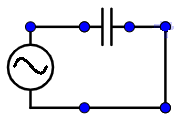
In an a.c. circuit an alternating voltage $e=200 \sqrt{2} \sin 100t$ volts is connected to a capacitor of capacity 1$\mu$F. The r.m.s. value of the current in the circuit is:
A. 10 mA
B. 100 mA
C. 200 mA
D. 20 mA
Answer
579.6k+ views
Hint: The emf of the supply voltage is given in the question. Like a resistor, a capacitor also creates some voltage drop across. It has some 'impedance', which when multiplied by current gives the voltage drop across it.
Formula Used:
Capacitor's reactance (or resistance) is obtained as:
$X_C = \dfrac{1}{\omega C}$
Complete step by step answer:
Given, the supply:
$e=200 \sqrt{2} \sin 100t$ volts
And the value of C = 1$\mu$ F

We know that an alternating current source will have a supply voltage given by $V_0 \sin \omega t$ type of expression. We only compare this with our given supply voltage. The direct comparison gives us:
$V_0 = 200 \sqrt{2}$ volts
and
$\omega = 100$ Hz
The reactance of the capacitor can be found by plugging in the values as:
$X_C = \dfrac{1}{\omega C} = \dfrac{1}{100 \times 10^{-6}} = 10000$ ohms
We know, by ohm's law that the current I in the circuit with resistance R and supply voltage V is just V/R. Similarly, we can write:
$I_0 = \dfrac{V_0}{X_C}$
Thus,
$I_0 = \dfrac{200 \sqrt{2}}{10000}$A
But, we need to find the rms value of the current, so we use the formula:
$I_{rms} = \dfrac{I_0}{\sqrt{2}}$
Therefore, we can get:
$I_{rms} = \dfrac{2}{100}$A
Or, we can say:
$I_{rms} = 20$mA
Thus, the correct option (D). 20 mA. This is the value of rms ac current in the circuit consisting of 1$\mu$F capacitor.
Note:
If more components are present in the circuit, the situation becomes different. If two capacitors were present in series we had to use equivalent capacitance in the reactance formula. If a resistor would have been present we would have done some vector algebra as the current in a capacitor lags behind from a resistor.
Formula Used:
Capacitor's reactance (or resistance) is obtained as:
$X_C = \dfrac{1}{\omega C}$
Complete step by step answer:
Given, the supply:
$e=200 \sqrt{2} \sin 100t$ volts
And the value of C = 1$\mu$ F

We know that an alternating current source will have a supply voltage given by $V_0 \sin \omega t$ type of expression. We only compare this with our given supply voltage. The direct comparison gives us:
$V_0 = 200 \sqrt{2}$ volts
and
$\omega = 100$ Hz
The reactance of the capacitor can be found by plugging in the values as:
$X_C = \dfrac{1}{\omega C} = \dfrac{1}{100 \times 10^{-6}} = 10000$ ohms
We know, by ohm's law that the current I in the circuit with resistance R and supply voltage V is just V/R. Similarly, we can write:
$I_0 = \dfrac{V_0}{X_C}$
Thus,
$I_0 = \dfrac{200 \sqrt{2}}{10000}$A
But, we need to find the rms value of the current, so we use the formula:
$I_{rms} = \dfrac{I_0}{\sqrt{2}}$
Therefore, we can get:
$I_{rms} = \dfrac{2}{100}$A
Or, we can say:
$I_{rms} = 20$mA
Thus, the correct option (D). 20 mA. This is the value of rms ac current in the circuit consisting of 1$\mu$F capacitor.
Note:
If more components are present in the circuit, the situation becomes different. If two capacitors were present in series we had to use equivalent capacitance in the reactance formula. If a resistor would have been present we would have done some vector algebra as the current in a capacitor lags behind from a resistor.
Recently Updated Pages
Master Class 12 Social Science: Engaging Questions & Answers for Success

Master Class 12 Chemistry: Engaging Questions & Answers for Success

A man running at a speed 5 ms is viewed in the side class 12 physics CBSE

The number of solutions in x in 02pi for which sqrt class 12 maths CBSE

State and explain Hardy Weinbergs Principle class 12 biology CBSE

Write any two methods of preparation of phenol Give class 12 chemistry CBSE

Trending doubts
What are the major means of transport Explain each class 12 social science CBSE

Which are the Top 10 Largest Countries of the World?

Draw a labelled sketch of the human eye class 12 physics CBSE

Explain sex determination in humans with line diag class 12 biology CBSE

Explain sex determination in humans with the help of class 12 biology CBSE

Differentiate between homogeneous and heterogeneous class 12 chemistry CBSE




